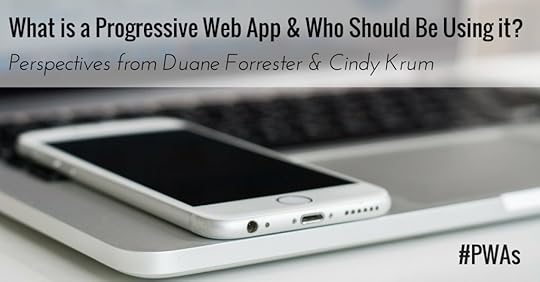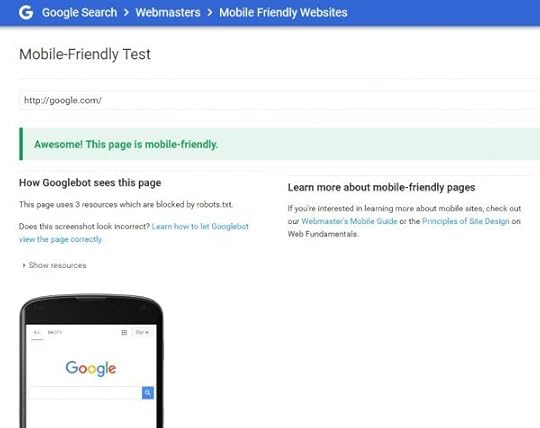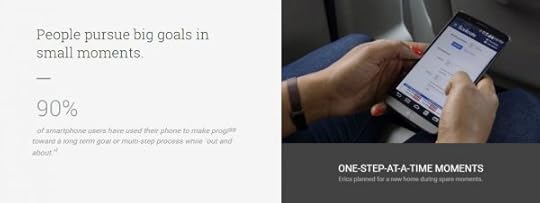Bruce Clay's Blog, page 8
December 12, 2016
Why You Won’t Recognize Google Local Listings in a Year: Home Services Ads Explained by Bruce Clay
Why You Won’t Recognize Google Local Listings in a Year: Home Services Ads Explained by Bruce Clay was originally published on BruceClay.com, home of expert search engine optimization tips.
Imagine a search engine results page with four paid ads at the top and three more sponsored local listings in the Local Pack.
That’s seven ads at the top of every page.
That’s where we’re headed with Google Home Service Ads.
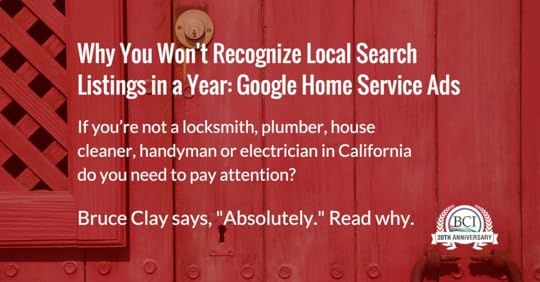
Google Home Service Ads are Expanding
Google Home Service Ads are sponsored listings in the Google Local Pack. Here’s what they look like:
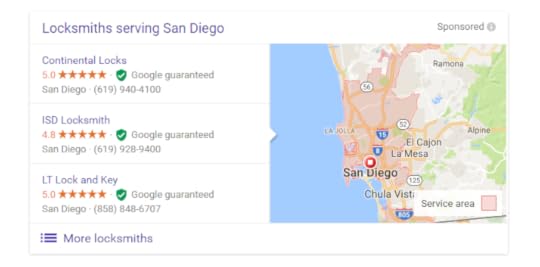
What Are Google Home Service Ads?
Google Home Service Ads beta-launched on July 30, 2015.
The invite-only program enabled plumbers and locksmiths in California’s Bay Area to become Google Guaranteed Service Providers and appear atop the newly “Sponsored” Local Pack.
Since then, the pilot program has expanded to San Diego and Sacramento and is now open to handymen, electricians and house cleaners, as well.
The program is slated to soon expand to Los Angeles.
Along with expanded locales, Home Service Ads expanded to mobile search results. As of Nov. 21, Google Home Service Ads can now show up on mobile search engine results pages, complete with service area maps.
Although Google Home Services Ads are still in beta, and you’ll only find them if you’re searching for locksmiths and plumbers in the Bay Area, Sacramento and San Diego, Google Home Service Ads are here and brands and businesses need to be aware.
Google Home Service Ads are only going to keep expanding.
If Sponsored Listings Aren’t Available for My Industry Do I Still Need to Pay Attention?
If you’re not a locksmith, plumber, house cleaner, handyman or electrician in the Bay Area, Sacramento or San Diego, do you need to be paying attention? Absolutely.
Paid inclusion is a reality and it’s only a matter of time before it rolls out to all local businesses. Google is in the business of making money. Therefore, it’s in Google’s best interest to monetize local listings across industries, nationwide.
Why Is Google Monetizing Local Listings?
If paying a “lead fee” to be ranked at the top of local listings, even with an ad designation, is not paid inclusion, then what is?
You pay — and you jump above the others.
Do not be fooled. This is a revenue opportunity for Google and it is expected to spread quickly.
As with PPC ads, you’ll get more keyword data using Google’s Home Service Ads.
The way things are headed, business owners will have no choice but to buy Home Service Ads.
Listen to this: SEO Jim Froling shared an eye-opening story in a thread on Local Search Forum about Home Service Ads.
One of Froling’s clients, a locksmith in Oceanside, California, was contacted by Google. The Google representative told the client that “his Google My Business listing was going away and that he would have no local visibility unless he signed on with Home Service Ads.”
Paid inclusion (aka Home Service Ads) will become the only chance local business have to appear in Local Packs.
How Long Until Google Home Services Roll Out to My Industry?
How soon before paid inclusion is a reality across all industries? Perhaps sooner than you’d think. Remember when AMP (Accelerated Mobile Pages) was just for the publishing industry? AMP launched for news publishers on Oct. 7, 2015. Less than a year later, it was available to all sites in all industries.
Local Listings Have Never Been Organic
There’s been a common misconception that local listings were an organic space, and therefore would always be free from ads. But local listings are not an organic space, nor have they ever been.
Local listings have always been an opt-in opportunity, based on information provided by businesses.
Unlike organic search results, Google local listings were never based on public trust information or information gathered from the web – you don’t even have to have a website to have a local listing. It’s a Google-owned directory.
Paid inclusion has been in the cards for years. The expansion of Google Home Service Ads comes as no surprise to me. I’ve been doing SEO since 1996, and I share my annual digital marketing predictions every year.
Back in 2012, I wrote:
“Local results become a massive revenue source for the search engines. A local paid inclusion program develops where brick and mortar sites can get local result preferential listings for a reasonable monthly fee. Some engines will offer comprehensive call tracking and analytics for local paid inclusion programs.
Local Paid Inclusion will replace traditional SEO and PPC as the first traffic tactic. Premium listings in local results will immediately gain popularity as early adopters happily get traffic for a low fee in a matter of days. This will be the most significant traffic tactic in 2012. Everyone that has a local address will participate.”
Pay attention as Google Home Service Ads roll out across all local industries. You’re going to need to strengthen your local SEO strategy and possibly increase your local listings budget in Google’s increasingly pay-to-play ecosystem.
Let us help you drive and track traffic to your website with a local SEO and PPC strategy. BCI’s services are tailor-made to match your business goals and audience. Let’s talk more about growing revenue through digital marketing.
December 9, 2016
You Won’t Recognize Google Local Listings in a Year: Home Services Ads Explained by Bruce Clay
You Won’t Recognize Google Local Listings in a Year: Home Services Ads Explained by Bruce Clay was originally published on BruceClay.com, home of expert search engine optimization tips.
Imagine a search engine results page with four paid ads at the top and three more sponsored Local Listings in the Local Pack.
That’s seven ads at the top of every page.
That’s where we’re headed with Google Home Service Ads.
Google Home Service Ads are Expanding
Google Home Service Ads are sponsored listings in the Google Local Pack. Here’s what they look like:
 What are Google Home Service Ads?
What are Google Home Service Ads?Google Home Service Ads beta-launched on July 30, 2015. The invite-only program enabled plumbers and locksmiths in California’s Bay Area to become Google Guaranteed Service Providers and appear atop the newly “Sponsored” Local Pack.
Since then, the pilot program has expanded to San Diego and is now open to handymen, electricians and house cleaners, as well. The program is slated to soon expand to Los Angeles. As of Nov. 21, Google Home Service Ads can now show up on mobile search engine results pages, complete with service area maps.
Google Home Service Ads are here — brands and businesses need to be aware. Google Home Service Ads are sponsored listings in the Google Local Pack. Although Google Home Services Ads are still in beta, and you’ll only find them if you’re searching for locksmiths and plumbers in the Bay Area and San Diego.
If Sponsored Listings Aren’t Available for My Industry Do I Still Need to Pay Attention?
If you’re not a locksmith, plumber, house cleaner, handyman or electrician in the Bay Area or San Diego, do you need to be paying attention? Absolutely. Paid inclusion is a reality and it’s only a matter of time before it rolls out to all local businesses. Google is in the business of making money. Therefore, it’s in Google’s best interest to monetize local listings across industries, nationwide.
Why is Google Monetizing Local Listings?
If paying a “lead fee” to be ranked at the top of local listings, even with an ad designation, is not paid inclusion, then what is? You pay — and you jump above the others. Do not be fooled. This is a revenue opportunity for Google and it is expected to spread quickly. As with PPC ads, you’ll get more keyword data using Google’s Home Service ads.
The way things are headed, business owners will have no choice but to buy Home Service Ads. Listen to this story: SEO Jim Froling shared an eye-opening story in a thread on Local Search Forum about Home Service Ads. One of Froling’s clients, a locksmith in Oceanside, California, was contacted by Google. The Google representative told the client that “his Google My Business listing was going away and that he would have no local visibility unless he signed on with Home Service Ads.”
Paid inclusion (aka Home Service Ads) will become the only chance local business have to appear in Local Packs.
How Long Until Google Home Services Roll Out to My Industry?
How soon before paid inclusion is a reality across all industries? Perhaps sooner than you’d think. Remember when AMP (Accelerated Mobile Pages) was just for the publishing industry? AMP launched for news publishers on Oct. 7, 2015. Less than a year later, it was available to all sites in all industries.
Local Listings Have Never Been Organic
There’s been a common misconception that Local Listings were an organic space, and therefore would always be free from ads. But Local Listings are not an organic space, nor have they ever been. Local Listings have always been an opt-in opportunity, based on information provided by businesses. Unlike organic search results, Google Local Listings were never based on public trust information or information gathered from the web – you don’t even have to have a website to have a Local Listing. It’s a Google-owned directory.
Paid inclusion has been in the cards for years. The expansion of Google Home Service ads comes as no surprise to me. I’ve been doing SEO since 1996, and I share my annual digital marketing predictions every year. Back in 2012, I wrote:
“Local results become a massive revenue source for the search engines. A local paid inclusion program develops where brick and mortar sites can get local result preferential listings for a reasonable monthly fee. Some engines will offer comprehensive call tracking and analytics for local paid inclusion programs.
Local Paid Inclusion will replace traditional SEO and PPC as the first traffic tactic. Premium listings in local results will immediately gain popularity as early adopters happily get traffic for a low fee in a matter of days. This will be the most significant traffic tactic in 2012. Everyone that has a local address will participate.”
Be paying attention, folks – as Google Home Service Ads roll out across all local industries, you’re going to need to strengthen your local SEO strategy in Google’s increasingly pay-to-play ecosystem.
December 1, 2016
What is a Progressive Web App & Who Should Be Using It?
What is a Progressive Web App & Who Should Be Using It? was originally published on BruceClay.com, home of expert search engine optimization tips.
According to Google, progressive web apps are the next big thing for “delivering amazing user experiences on the web.” In the same vein as AMP (accelerated mobile pages), PWAs are causing digital marketers to rethink the way they can design and deliver their sites in a mobile-first world. Website owners and designers need to be paying attention. So just what is a progressive web app?
What is a Progressive Web App?
It’s an all-in-one solution for web developers to create a single version website/app that can be delivered across all devices and works like an app but without the hassle of distribution through an app store.
A progressive web app, or PWA, combines the best of a website and the best of a native application. It’s a type of hybrid app. If a user comes to your PWA-run site, they’ll get the mobile version of your site but faster.
With a traditional hybrid app, like the Amazon app, the user’s interactions with it are built into the phone as an app, but the data collected is from the web. Here’s where a PWA is different. A PWA launches a browser to do the same thing. With the introduction of service workers (the scripts running in the background of your browser) and other technological advancements, browsers are more sophisticated than ever. They can do things on your phone that previously could only be done through a native app. This means you don’t have to publish the app in the app store. The barrier to entry of downloading an app is no longer an issue for your users.
As a developer, you no longer have to program different apps for different devices, nor deal with special screen sizes. You can invest your time and resources into designing a PWA. If you have to make a mobile website, you might as well just use a PWA. It’s well worth it.
Talking PWAs with Cindy Krum
My longtime friend Cindy Krum, the CEO and founder of MobileMoxie, is a PWA guru. I wanted to get her take on how far in the future the mass adoption of PWAs looks to be. Here’s what she had to say:
Lots of big companies are already testing PWA code and integrations on their sites. Lyft, Mic, Washington Post, Flipboard, The Weather Channel and more have already launched beta PWA sites for testing. Google has already published some PWA development guidelines for SEO, but I think the update may depend on how aggressively Google and other influential companies promote PWAs.
Google has also been hinting at cross-over between AMP and PWAs, using AMP to make PWA’s work in Safari, so there may be some new iteration of AMP that makes AMP enabled content available in PWA format. The PWA news viewer already behaves a lot like a PWA. My guess is that in the next year, we will see some of the more agile and cutting edge companies take their PWAs out of beta, and making them their main sites, with or without the influence of AMP.
It will be interesting to watch more widespread adoption of PWAs unfold. As with anything new, of course, it can sometimes be hard to get clients to adopt bleeding edge technology. Here’s how Cindy is getting her clients on board.
Cindy: The main recommendation is to try it out. You can add a service worker and an app manifest to any existing website. It is not enough to get the full benefits of a PWA, but it is enough to learn how easy or difficult the integration will be for your company. In our case, we developed an app manifest in five minutes, and a service worker in 90 minutes.
Making web-apps indexable tends to be the harder part of the equation, but that is true with or without the PWA elements. Web apps are hard to index because developers don’t always include URLs for state-changes in the web app.
For the immediate future, PWAs are something to be aware of, and if you’re able to, start working into your testing and planning cycles. There are no guarantees it’ll be the go-forward structure and remain supported by Google forever, but you don’t want to be left behind. There are practical upsides to PWAs that are worth considering regardless of how long it takes this to be a mainstream approach.
November 23, 2016
All-In-One Mobile SEO & Design Checklist
All-In-One Mobile SEO & Design Checklist was originally published on BruceClay.com, home of expert search engine optimization tips.
The mobile user experience really matters to Google. Proof:
As of 2015, more searches are performed on mobile than desktop, meaning mobile is the main device used worldwide for the majority of online browsing time. Google has been strongly emphasizing the mobile-first perspective ever since.
In April 2015, Google made a pre-announced update to the algorithm that ranks mobile search results. A website’s mobile friendliness officially was dubbed a confirmed ranking signal for mobile search rankings.
In late 2015, the Google Quality Rating Guidelines were updated with screenshots from the perspective of mobile devices.
In November 2016, Google pre-announced an update to its search index, moving to a mobile-first index. This means that Google uses your site’s mobile version in ranking calculations.
And this coming January 2017, sites that show an intrusive interstitial in the transition from a mobile search result to the content clicked will not rank as highly in Google results.
Google is optimizing its users mobile search experience and webmasters must be in lock step.
Consider this checklist your mobile SEO go-to resource.

If you’re already on board and optimizing for mobile, jump to the section that best suits your needs. If you’re new to the game, start from the beginning and use this checklist as a start-to-finish guide.
Table of Contents
Choose a Mobile Platform
Optimize Mobile Sites for Crawling and Indexing
Optimize for Page Load Speed
Optimize Design for the Mobile UX
Implement Analytics to Track Mobile Conversion Goals
Optimize Your Content for the Mobile Experience
Test Often and Optimize User Experience
1. Choose a Mobile Platform
There are primarily four varieties of mobile page strategies: responsive design, dynamic serving, separate mobile page and Accelerated Mobile Pages (AMP).
For both mobile and desktop searchers, Google is looking to rank web pages that show high relevance, trust and great user experience.
Remember, to rank for a target query Google needs to deem your web page the most relevant and “least imperfect” option for that query.
While your desktop-optimized web pages may be incredibly relevant, if your code does not allow for your content to fit the smartphone experience, Google recognizes this as a poor user experience. A poor user experience means your website gets further from “least imperfect” and your rank drops further down the SERP.
Since ranking high in mobile search results needs to be a priority, building a dynamic or separate mobile platform for your content needs to be a priority as well.
You have options for how to display your content for the mobile user agent and visitor: responsive design; dynamic serving; a separate mobile site; and Accelerated Mobile Pages (AMP).
The solution — or combination of solutions — that’s right for you will depend on many factors including development resources, conversion goals, mobile keyword research versus desktop keyword research, and persona behavior.
To figure out which mobile optimization strategy is best for you, we recommend reading:
A Cheat Sheet for Mobile Design: Responsive Design, Dynamic Serving and Mobile Sites — an article that compares and contrasts three technical options for a mobile website.
Building Smartphone-Optimized Websites portion of the Google Developers website.
Chapters one and two of Building Your Mobile-Friendly Site: The Distilled Best Practice Guide.
AMPProject.org for a technical introduction, tutorials and sample code for building an AMP HTML page.
2. Optimize for Crawling and Indexing
When optimizing your mobile platform, don’t forget about your technical SEO best practices.
If you skip the technical SEO on your mobile site, search spiders may have a hard time discerning mobile-specific content from desktop-specific content, which can create a bad user experience in both the mobile and the desktop experience.
Remember the basics: search engine spiders need to be able to discover, crawl and index your web pages in order for them to rank.
In other words, if a search spider cannot find and access your site pages, your site cannot rank.
To help search bots crawl, index and differentiate (if they are different) your mobile site pages, make sure you:
Create a mobile XML sitemap with a declaration after each URL listing.
Submit your mobile site and your mobile XML sitemap to Google Search Console.
Never design your mobile site using pop-up windows or lightboxes that cannot be discovered through a sitemap crawl.
Make sure to implement rel=canonical, rel=alternate media and Vary: User-Agent HTTP Header tags as needed to tell Google when it should deliver a desktop version of your web page and when it should deliver a mobile version.
Make sure to allow the Googlebot and Google Smartphone user agents to access your site.
3. Optimize for Page Load Speed
This is very important to both the user and the search spider!
According to the PageSpeed Insights portion of the Google Developers help site, Google prefers above-the-fold content to render in under a second on a mobile network.
Anything longer than a second, they say, can result in a poor user experience. The idea is to get users interacting with the page as soon as possible.
On the user experience end: According to Google and Strangeloop, 85% of mobile users expect sites to load at least as fast as desktop sites. So improving mobile site speed needs to be a goal.
To help get your mobile sites loading faster make sure you:
Focus on mobile image optimization to reduce load times.
Follow the page speed optimization recommendations outlined in the Mobile Analysis portion of the Google Developers PageSpeed Insights resource.
Use front-end optimization strategies, such as mobile-optimized caching, to address mobile performance issues and get mobile pages loading faster.
Regularly check your page speed using the Google PageSpeed Insights analyzer.
4. Optimize Design for the Mobile UX
In the context of mobile optimization, design describes the elements of the web page the end-user sees, and user experience (or UX) describes the experience that design creates for the user, how they interact with elements on the page, how the elements on the page make them feel, whether the site is easy to use or frustrating, etc.
Google wants happy, satisfied searchers, so user experience is a huge priority for the search engine. Create a bad above-the-fold user experience and expect your site to rank somewhere far from Page 1.
To really send home the importance of why mobile UX matters, consider this comment by a Google representative:
“According to our studies, 61% of users are unlikely to return to a mobile site that they had trouble accessing from their phone. That includes sites that use fonts which are illegible on mobile, or sites where users have to zoom in or pan around excessively.”
Straight from Google. More than half of your inbound traffic is unlikely to return to your mobile site if they are met with a poor user experience. This means serious loss in conversion, as well as loss of mobile rank.
To get your web pages designed and optimized for UX, we recommend starting with these considerations:
Read Google’s 25 Principles of Mobile Site Design to learn what Google considers “mobile site design best practices.”
Consider how your buttons look, feel and function:
Are you using Click-to-Call buttons?
Is your logo a button that makes it easy to get back to your home page?
Are your buttons finger friendly?
Have you placed your most important CTA button above the mobile fold?
Consider the UX of your mobile site search:
Is the site search visible above the fold in your mobile design?
Can you add filter elements to make searching your site on a mobile device easier?
Did you make sure it’s impossible for search filters to return zero results?
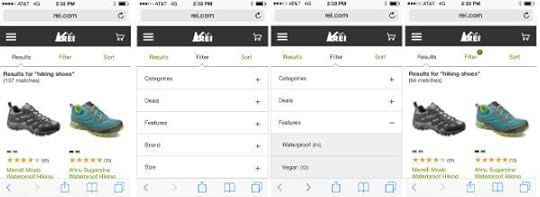
The REI mobile site makes it easy to filter search results.
Is your mobile experience optimized for task completion?
Can your forms be simplified?
Can login requirements be simplified? Can users purchase as a guest?
Are your menus working for the user? Can you simplify them? Would your pulldown menu work better as toggle menu?
Would a third-party payment service make paying with a mobile device easier for your end user?
Do any of your forms or other windows open in a pop-up window or lightbox? If yes, fix this. Pop-up windows and lightboxes are bad for UX and SEO.
Does your user have to pinch, scroll side to side or zoom out to see your web pages? If yes, fix this. The Google representative quoted above specifically referenced a user having to “zoom in or pan around excessively” as an example of bad user experience. Your mobile platform should deliver web content that is sized to fit mobile devices.
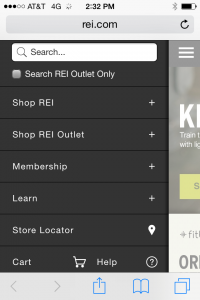
An example of a mobile toggle, or hamburger, menu.
5. Implement Analytics to Track Mobile Conversion Goals
It’s not a new concept. How can you understand where your web pages are succeeding and failing if you’re not tracking activity with analytics?
Don’t overlook this important step on your mobile platform to show ROI in exchange for buy-in and budget.
Make sure to:
Implement analytics across your mobile site.
Develop intelligent mobile- and conversion-centric metrics that give insight into how your personas are interacting with your web pages. Remember to look at micro-conversions and device-specific bounce rate.
When possible, define your mobile goals early then build mobile web pages with a task flow that makes conversion easier for the user.
Remember desktop rank and mobile rank can differ greatly. Page one in mobile SERPs tends to include significantly fewer organic results than desktop SERPs, and the keywords your personas are using to search for you in the desktop experience are not necessarily the words they’re using in mobile. Make sure your mobile stats are coming from true analysis of mobile SERP activity.
Make reporting easier by setting up a custom mobile campaign dashboard.
Monitor mobile site speed in Google Analytics by navigating to Content > Site Speed.
6. Optimize Your Content for the Mobile Experience
I won’t say “content is king” one more time, but I will say content really matters. Content is the means by which your users get to know you, your products and your services. Thoughtful content is truly key to conversion. Plus, without strategic content you can’t optimize your web pages for keywords, which means your web pages can’t rank in the desktop or mobile experience.
When approaching content creation with an eye toward mobile optimization think:
Is your content resonating with mobile users? Don’t set it and forget it. Instead, keep on adding and testing content types and measuring the corresponding mobile tracking variables.
All mobile content is not created equally. What works and reads well on one device type might not work at all on another (think smartphone experience versus tablet experience).
Is your content easily read without excessive scrolling or zooming? Are your digital assets – images, videos, navigation, etc. – easy to see without scrolling or zooming?
Are you calls to action front and center? Can you place a call to action above the fold?
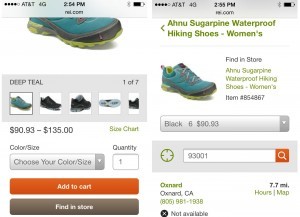
Here, the REI mobile site uses a “Find in store” button to optimize for local UX.
Can your content be optimized for local? For instance, can you include the stock of product available nearby like REI does?
62% of keywords have different ranks between desktop and mobile. Have you done mobile-specific keyword research? Are your mobile users using search phrases that are very different from the phrases your desktop searchers are using? If yes, consider using dynamic serving to deliver mobile-optimized content to your mobile users.
Are your meta tags optimized? When appropriate or necessary, are they optimized specifically for mobile?
Social content is mobile content. Are you integrating your search, social, video and mobile campaigns?
7. Test Often and Optimize User Experience
So you picked a mobile platform, designed your mobile pages with user experience in mind, and created mobile-optimized content. Great! Now… is it working?
Does it look like you intended it to look? Is Google seeing it how you think Google should be seeing it? Are all the usability features you built into your web pages actually working for your users?
Don’t set it and forget it. Mobile optimization is all about testing and retesting over and over again.
While testing is the final step in our checklist, remember that testing isn’t like putting a fork in it and calling it done. As an optimizer your work is never done, instead you should consider it “done for now until it’s time to test again.”
When testing and retesting your mobile web efforts, make sure to consider these factors:
Have you tested on a range of devices using an emulator, or a series of actual devices?
With each website release, the configuration needs to be checked.
Are you testing your UX using real people that represent your personas? Have your friends and family test your site.
Have you recently run your mobile-optimized website through the Google PageSpeed Insights tool to glean insights about user experience and site speed? (Don’t miss the User Experience section of the SiteSpeed Insights tool!)
Google will add snippets to mobile SERPs warning searchers when the website they see listed may yield a sub-optimal user experience. Warnings include “Uses Flash” and “May not work on your device.” Have you checked to see whether your site is being amended with Google warnings in mobile SERPs?
Use the W3C Mobile Checker to test your website’s true mobile-friendliness.
Anything Worth Doing Is Worth Doing Right
Hunter S. Thompson wasn’t thinking of mobile website optimization when he said “anything worth doing is worth doing right.”
Yet there’s no better quote to emphasize not only the importance of mobile SEO, but more so the importance of effective mobile SEO; of not just optimizing for mobile, but optimizing the right way for mobile.
Times are changing and the way that people use and access the internet is changing, so we as marketers need to be changing the way we think, analyze, create, package and deliver content.
How are you optimizing your web pages to make sure they are mobile ready?
For more information on how to optimize your pages for speed and mobile SEO, we recommend these resource:
Google Developers Mobile Friendly Websites
AMPProject.org
SEO Tutorial: Mobile SEO and UX Optimization
Let us help you drive and track traffic to your website with a mobile-first SEO strategy. BCI’s services are tailor-made to match your business goals and audience. Let’s talk more about growing revenue through digital marketing.
This post was originally published by Chelsea Adams on Oct. 29, 2014, and updated on Nov. 23, 2016.
November 16, 2016
How Well Do You Understand the Google Mobile-First Index? Mobile SEO Quiz
How Well Do You Understand the Google Mobile-First Index? Mobile SEO Quiz was originally published on BruceClay.com, home of expert search engine optimization tips.
Google reaffirmed in a Nov. 4 post on the Webmaster Central Blog that a mobile-first index is coming.
I think many people have heard the news. I think many of those people are confused by it.
Are you clear on how a mobile-first index will impact your websites, clients and mobile SEO strategy?

See how many of the questions on this eight-question quiz you get right. (Skip straight to our mobile-first checklists.)
1. True or false: Google has two search indexes: a mobile-first index and a separate index of desktop sites.
False. Google has said that they have only one index. There will not be two different indexes for mobile sites and desktop sites, despite the massive amount of confusion.
.@BermanHale No separate mobile index. Gary was misinterpreted. And everything I said should still be as true. https://t.co/bXK3QAcpfk
— Paul Haahr (@haahr) November 5, 2016
However, the algorithms are different for mobile and desktop search results.
Google has decided that mobile is the first priority in everything they do and represent.
More people are going to search on a mobile device, therefore all the results are going to be optimized for a mobile device. Hence, Google designs a separate mobile algorithm, but a single, mobile-prioritized index.
Google is going toward a mobile-first index because Google has decided that’s where the market is going.
But we should understand that for responsive sites, the page is the same on desktop and on mobile, thus the indexed content is the same.
I stress that this change is fundamentally around mobile algorithmic variables being weighted first.
2. True or false: Mobile-friendliness is pass or fail.
False. While the results of the Google Mobile-Friendly Test are binary — you’re either gruesome or awesome — I’d bet there’s a hidden scale in the Mobile-Friendly Test.
If you run your site in the Mobile-Friendly Test, you might get “awesome” but you may be only 71 percent of the way to being optimized for the mobile UX.
Don’t settle for an “awesome” result and assume you can’t get better. Google has a tendency to change the rules, and awesome today may not be good enough tomorrow.
3. True or false: An SEO strategy is constructed for the mobile ranking algorithm, not the mobile-first index.
True. It used to be the case that a responsive site, if not particularly mobile friendly, could still rank on a desktop, and that site could still show up on a mobile SERP.
Search engines have a different expectation for how the page and elements of the page perform on mobile, items tested by the Mobile-Friendly Test, for instance.
The Google opinion is that if it takes longer than 3 seconds to load a page, they’re not going to show that page in their search results.
They’re going to keep track of page performance, and slower pages will suffer in the rankings.
They expect everything to display in the initial screen above the fold in under a second.
Along with mobile-friendly optimizations, expect ranking-related AMP issues, and other things that have yet to be announced. These factors influence whether or not a mobile site is ready for prime time and ready for showing up in the Google search results.

4. True or false: A good desktop site that functions on mobile is better than a broken mobile site.
True again. There was a clear caveat in the Google announcement: if today you only have a desktop site, don’t rush out and publish a poor mobile site. From the Webmaster Central Blog announcement:
“If you are building a mobile version of your site, keep in mind that a functional desktop-oriented site can be better than a broken or incomplete mobile version of the site.”
Make sure you’re serving visitors rather than checking boxes; make sure that the functionality is all there.
5. True or false: A responsive site is a good user experience.
False! Don’t mistake a responsive site for a good mobile UX. You might think that your site is responsive, pages are resizing – but consider the user experience.
Resizing is just one part of a responsive and mobile-friendly site. What is the user doing differently on a phone?
People search differently on mobile vs. desktop. What info is someone looking for on a mobile site and how easy is it for the user to find it?
6. True or false: User intent differs from mobile to desktop.
True. We used to think about user intent as “Do, Know, Go” – complete a transaction, get information, or navigate to a web or physical location.
Today we think of user intent in terms of “micro moments”; there are so many degrees of user intention that mobile web browsing affords.
82 percent of smartphone users turn to their phone to influence a purchase decision while in the store.
91 percent of smartphone users use their phone to get ideas while performing a task.
90 percent of smartphone users get things done online toward a long-term goal or multi-step process while out and about.
Source: Think With Google Intro to Micro-moments
What sort of info is someone likely to be looking for on your mobile site, and how easy is it for someone to find that information?
How well are you catering to people visiting from a phone?
Are your links smart? Are your location and hours easy to find, and do you have markup on those?
How does your site search work?
For someone looking for your business location, are your directions marked up with structured data?
Do you have markup on pages? From the Google blog post: “Make sure to serve structured markup for both the desktop and mobile version.”
7. True or false: People consume different content types on mobile.
True, of course. Catering to the mobile experience is much broader than sizing and formatting.
Have you thought about what people are doing on their phones?
Navigation, images and content that is easily digested is key to mobile success.
Unique to the mobile experience is performing voice searches and a higher demand for finding brick-and-mortar locations.
And then there’s the time spent on a mobile device viewing videos. That means mobile SEO includes optimizing for video search or optimizing for a YouTube search.
8. True or false: AMP could be a game changer, in more ways than we imagine.
I’m predicting this will be true.
We know AMP is a dominant algorithmic variable. Consider the SEO benefits of AMP on top of the mobile-first index, and AMP could be irresistible to highly competitive enterprise organizations.
In time, as AMP and mobile-friendliness factors get ratcheted up in the mobile algorithm, the definition of a top-ranked organic site may be that you bought into AMP and you got your organic listing by spending a ton of effort to optimize your site in AMP.
Mobile-First Index SEO Prep Checklists
We develop checklists around the technical processes we do for our clients. For our general SEO checklist, check out the Always Up-to-Date SEO Checklist.
To make sure our client sites are ready for the mobile-first index, we created these mobile-first checklist items to use along with our All-in-One Mobile SEO & Design Checklist.
Use this checklist to prep your sites with responsive design.
In general, no extra work needs to be done for a fully and properly configured responsive site because the same content exists for mobile and desktop, adjusting to the browser and size of either. However, confirm two things:
Make sure the site passes Google’s Mobile-Friendly Test. (Note: The Crawl Errors report in SEOToolSet gives the same report for responsive sites.)
Make sure that your navigation is usable by visitors.
The mobile-first index will no longer devalue content that is hidden behind tabs or accordion elements. Make sure that such content is accessible to people landing on a mobile page and that it is appropriately optimized from an SEO point of view.
Use this checklist to prep separate mobile sites.
In addition to the above two points, here’s a check list of additional safeguards to take for clients with a separate mobile site:
Check the mobile site with Google’s robots.txt testing tool to ensure that Googlebot is not blocked.
Review the mobile site’s content depth to make sure it will merit the long-tail searches that the desktop site qualifies for.
Make sure any structured markup on the desktop site also exists on the mobile site (to protect featured snippets and other SERP elements).
Note: Canonical tags may be left in place (assuming they are implemented correctly on the mobile site).
Google has decided that being mobile-friendly and being fast is critical. The announcement isn’t news because Google has been discussing this at conferences for a long time.
Still there’s much to do in adapting to the fact that user intent, content consumption and varying form factors differ from mobile to desktop.
Let us help you drive and track traffic to your website with a mobile-first SEO strategy. BCI’s services are tailor-made to match your business goals and audience. Let’s talk more about growing revenue through digital marketing.
November 2, 2016
How to Build a Google Analytics Tracking Code
How to Build a Google Analytics Tracking Code was originally published on BruceClay.com, home of expert search engine optimization tips.
Need more input?
Like Johnny Number 5 eats the Encyclopedia Britannica in the above clip from the 1986 gem “Short Circuit,” as optimizers we are constantly looking for more input.
Google Analytics tracking codes are one way we can track how recipients are interacting with our content.
Also known as UTM codes, tracking parameters or custom campaigns, Google Analytics tracking codes are custom tracking parameters that communicate granular information about how visitors interacted with your calls to action to arrive at your owned properties.
This guide describes:
When to use a tracking code
How to format a tracking code
Favorite tools for building UTMs
7 essential guidelines for formatting tracking codes
Jump to each section with the links above … or dive in now.

When to Use a Tracking Code
Use UTM tracking codes to see how traffic came to your owned web properties from across the web.
Use a tracking parameter any time you link to a URL on a domain or app you own. You will get the tracking data in Google Analytics for verified domains.
You can use UTM tracking parameters when linking to your owned property from any location: banner ads, email newsletters, social media content, and any other campaign that links people to a property that you own and manage in Google Analytics.
You cannot use UTM tracking to analyze clicks to third-party websites, like YouTube.com or Wikipedia.org. To track click activity on links that send people to properties you don’t own, Bitly is a great resource — and it’s free.
How to Format a UTM Tracking Code
To implement a UTM tracking code, add your parameters to the end of the URL you want to track for insights.
Here’s an example URL with UTM. In this example, the link is posted to Facebook.
http://www.bruceclay.com/blog/amplify...
Part 1: URL of the page you’re linking to with a “?” at the end
Part 2: utm_source=
Part 3: utm_medium=
Part 4: utm_campaign=

Bruce Clay, Inc. does not recommend or condone using “awesome” as a Google Analytics UTM code parameter. (But we may or may not find it amusing.)
How to Put Together a Google Analytics Tracking Code
There are five possible parameters you can set for each UTM tracking code:
Source
Medium
Campaign
Content
Term
You should always use the Source, Medium and Campaign parameters; Content and Term are optional and primarily used for paid advertising. Google goes into detail about each parameter type in its support page here.
To keep this guide simple, we will only discuss how to use the three required parameters: utm_source, utm_medium and utm_campaign.
Source
Google defines the Source parameter as such:
utm_source: Identify the advertiser, site, publication, etc. that is sending traffic to your property, for example: google, newsletter4, billboard.
Common Source parameter data used within the BCI content and social media department include blog, newsletter, facebook and twitter.
Medium
Google defines the Medium parameter as such:
utm_medium: The advertising or marketing medium, for example: cpc, banner, email newsletter.
Medium conveys the big picture — how to classify the medium by which your link was presented to the user.
Campaign
Google defines the Campaign parameter as such:
utm_campaign: The individual campaign name, slogan, promo code, etc. for a product.
The Campaign parameter is even more specific than Source, and the parameter where you can really start to get granular with your tracking.
The Campaign parameter gives you the power to identify the specifics of a link placement, all the way down to the color and size of the call to action, if desired.
To illustrate, here are four of the most recent Campaign parameters we’ve used in content marketing efforts:
utm_campaign=smm: The content we publish to the blog may serve to deepen our expert, authority content supporting our silos, or content themes. For example, I linked to the last post on Snapchat marketing for millennials with the Campaign parameter “smm” so that I can see how popular our social media marketing content is.
utm_campaign=toolset61upgrade: With the release of SEOToolSet 6.1, we engaged in a campaign to invite SEOToolSet Lite subscribers to try the newest tools release. Links from our engagement email campaign contain this Campaign parameter.
utm_campaign=liveblog: Our conference liveblogging is a campaign. We invest in sending livebloggers to major digital marketing conferences with the goal of driving traffic to the site. Understanding when we’re getting traffic from liveblog content is key to evaluating this investment.
utm_campaign=seonewsletter-101816: We publish the SEO Newsletter monthly. The campaign “seonewsletter” tells us that traffic to the site is drawn by newsletter content. The date tells us what edition of the newsetter they clicked to see.
Tools for Building UTMs
You’re going to get pretty good at hand-typing a UTM pretty fast after you’ve done it a few times.
But if you’d rather use a tool to create the UTM for you, keep these handy.
Google Analytics Campaign URL Builder
UTMftw with chrome extension and available custom GA dashboard
7 Essentials Guidelines for Formatting Google Analytics Tracking Codes
1. Every UTM tracking code starts with a question mark (?utm_). This question mark tells Google Analytics where your link URL ends and your tracking starts.
If you don’t include the question mark, Google will think your link is http://www.yourwebsite.com/your-cro-l...-articleutm_source which, as an alteration of the URL permalink, will result in a 404 error. The question mark is important.
2. There are five possible parameters you can set for each UTM tracking code: Source, Medium, Campaign, Content and Term.
The parameters you choose to use are strung together in one sentence (no spaces) and separated by ampersands (&).
3. It doesn’t matter what order you list your parameters in, but your first parameter must start with a question mark and all the following parameters must start with ampersands.
The “&” tells Google Analytics where one parameter ends and the next begins.
If you forget the ampersand and write your code like ”&utm_medium=viralutm_campaign=” Google Analytics will think that your Medium is “viralutm_campaign=” which, as you can imagine, will skew your Medium and Campaign data pretty badly.
4. The best practice is to use dashes to separate words in a UTM parameter.
If you end up using spaces, Google Analytics will fill in the spaces with the percent sign or plus sign.
Dashes are preferred to underscores, although both work. For the backstory, see Matt Cutts’ behind-the-scenes explanation: dashes vs. underscores.
5. UTMs are case sensitive. Keep it simple. Stick with lowercase.
UTM codes are case sensitive so Google Analytics will collect data for potatoes and Potatoes as two separate reports.
Since Google Analytics does not have the human sensibility to tell you that there is a capitalized version of your Campaign floating around somewhere in your referral traffic data, you may be analyzing incomplete data if your team isn’t careful about capitalization.
6. You must own the destination of a URL in order collect data from attaching a UTM to it.
In other words, you can only use UTM tracking to assigned parameters to links that go to your properties — your website, your blog, your app, etc. You cannot use UTM tracking to analyze clicks that go to properties you don’t own, like your page on Facebook.com or your store on Amazon.com.
7. And finally, it is critical to have a discussion about UTM parameter conventions before anyone on your team starts creating UTM codes willy-nilly.
The Google Analytics URL builder makes it easy for your team to stay in sync when creating and propagating UTM tracking codes. Create a spreadsheet or other living document (a Google Drive spreadsheet works great) that clearly outlines internal conventions and consistent parameters.
The last thing you want is your campaign data split among variations, caused by issues as simple as pluralization or capitalization. You may be analyzing incomplete data if your team isn’t consistent. It’s good to have team-wide ground rules that everyone is aware of. For example, “stick with lowercase” is a good rule of thumb.
Why Use Tracking Codes?
Use Google Analytics tracking codes to measure where referral traffic is coming from, which initiatives are meeting traffic goals, how target markets prefer to receive communication, and the ebb and flow of an industry based on seasonality.
Are you a Johnny Number 5? UTMs give you a granular snapshot of your traffic, how your consumers (and potential-consumers) are interacting with the calls to action you’re putting out there, and they are a great way to quench an unrelenting need for ROI data.
Let us help you drive and track traffic to your website from organic search, paid search, content marketing and social media. BCI’s strategic services are tailor-made to match your business goals and audience. Let’s talk more about growing revenue through digital marketing.
This post was originally published on May 16, 2013, and updated on Nov. 2, 2016.
October 28, 2016
Millennials ❤️ Snapchat: 15 Tips on How to Use Snapchat for Business
Millennials ❤️ Snapchat: 15 Tips on How to Use Snapchat for Business was originally published on BruceClay.com, home of expert search engine optimization tips.
AUTHENTICITY.
ACTIVE LISTENING.
INNOVATION.
This is the high standard that we face today as marketers — that our customers demand from us.
The rules of commercial and social discourse have been rewritten.
92% of online shoppers consider reviews in their buying decisions.
67% (two out of three) companies note that customer service in social media is gaining importance.
If your business is in business it’s because you’ve committed to a new set of marketing best practices.
Marketing in the digital age is centered on being open about your professional mission, prioritizing your customers’ voices, cutting back on the sales pitches, and getting noticed for going above and beyond.
… Which brings us to Snapchat.
Courting millennials? Why Snapchat is good for business
Snapchat is a social platform whose community rewards openness, intimacy and authenticity.
It’s the app millennials (17- to 34-year-olds) use to chat with friends and get their entertainment and lifestyle news.
As author of “Social PR Secrets,” Lisa Buyer, said, “Snapchat reminds me of the pioneer days. There’s a lot of experimenting going on — unique and creative things happening. There are so many things brands can do using Snapchat that have never been done before.”
Mapping your audience to Snapchat
So does Snapchat have the potential to benefit your business? To answer that, first decide if your audience is there.
Here are some stats on Snapchat users:
150 million daily active users
Percent of users that are millennials: 73%
Daily users: 54%
Daily amount of in-app time spent: 30 minutes
Percent of U.S. millennial internet users that access Snapchat regularly: 30%
Number of daily video views: 10 billion
The big opportunity for businesses here is connecting with millennials.
Millennials are a market segment with growing spending power and intense brand loyalty. It follows, then, that Snapchat is the social media channel that businesses are warming up to.
How to get started with Snapchat for business
Mana Ionescu and her company Lightspan Digital are among the pioneers of the Snapchat marketing space.
What industries and businesses are likely to find their audience on Snapchat? Ionescu said:
“If your customers and supporters are 34 or younger, they’re on Snapchat. Even the 34+ group is growing, and growing at a faster pace than the millennial group.
Companies and organizations in entertainment, sports, hospitality, consumer goods should jump on now.
It’s not just that these audiences are ravenous consumers of content (according to a study by Newscred, 55% of Snapchatters use it daily), but the medium itself is perfect for delivering quick news bites and telling stories through sequences of images and short videos.”
Ready to put Snapchat to work for you?
‘14 Rules to Get Snapchat Love’ by Mana Ionescu at Pubcon Las Vegas
If you’re committed to courting millennials and a tech-savvy set, and if you agree that authenticity, active listening and innovation are moving the needle for your business, then let’s get you up and running on Snapchat.
Ionescu shared 14 rules for Snapchat for business at Pubcon Las Vegas this month. I attended the session, wrote up my notes, and offer them here as a sort-of post-liveblog report.
(For more, here’s Ionescu’s own Snapchat for Business getting started guide.)
A preface: A lot of these tactics (and maybe Snapchat in general) won’t work for you if you’re a B2B. If you’re a B2C and willing to invest in Snapchat, remember that you have to do the work. It’s difficult work that Ionescu describes as “real-time storytelling.” On Snapchat, as with all social media, your brand has to be present.
1. Get followers
Step 1, you have to get followers.
How? Make a promise and stick to it.
Promise something that no one can get anywhere else. Another way to look at this is a unique value proposition for your Snapchat engagement.
Typically, brands on Snapchat are promising and delivering deals, updates, intimacy and fun.
FYI: 58% of college students say they are likely to purchase a product from a brand that sent them a coupon on Snapchat.
You’ll also need to post calls to action to get Snapchat followers.
Place your “follow us on Snapchat” CTAs everywhere using your snap code and username. Tip: A username is the easiest way to find a user; a lot of people aren’t searching by snap codes.
Other ways to get followers are:
Get listed in apps/directories such as Ghost Codes.
Get involved in a Reddit sub and publish your Snapchat username.
Run ads on other social networks to direct people to your account.
The rest of these rules are all cool things to do on Snapchat.
2. Post in Snapchat style
Snapchat is a community that has developed its own style and language. Keep it short, fun, designed in the snapchat style (stickers, filters, text and drawings over images … you’ll start to see the trends) and interactive.
Ionescu says that Urban Dictionary is the vocabulary of Snapchat.
3. Share exclusive deals
Make deals scarce, urgent and exclusive.
Just a few days ago Snapchat changed it so that Stories don’t automatically play. You’ll need to find ways to get people coming back and watching your stories. Exclusive deals and content is one tactic.
4. Announce things
Having a sale? Carrying a new product? Drive awareness and store visits.
5. Boost your photographer and videographer game
Snapchat is a true contender when it comes to video. Facebook gets 8 billion video views a day. Snapchat gets 10 billion.
We all have to spend some time learning how to take videos and photos. Quick tips: use striking visuals first; pay attention to contrast and line.
6. Master the hacks
Switch between front-facing and back-facing cameras with double tap. Zoom in and out while taking video by scrolling your finger up and down. Master doodling by using a stylus or tablet.
7. Tell stories with a sequence of pics and videos
Get past the 10-second limit with a sequence of images and videos that tie together.
Advanced social media marketing pro tip from BCI’s social media editor, Kristi Kellogg: Save your string of photos and videos to your camera roll and then repurpose that video on other social platforms, from Instagram to Facebook!
8. Get intimate
Snapchat, more than any social media platform to date, demands intimacy.
It’s like being in a true relationship. It has to do with trust. It has to do with spending time together. It has to do with having conversations, being vulnerable and sharing behind-the-scenes content.
Get your people involved as a way to build intimacy.
9. Run an ad campaign
If you have (big!) budget, sponsored campaigns start at $100,000. Kraft saw a 13% lift in purchase intent after a Snapchat sponsored campaign.
10. Run a contest
As a prize, maybe even to every participant, offer a coupon for your shop! (Fun case study of a froyo shop’s contest here.)
11. Do an influencer takeover
Influencer takeovers on Snapchat are guaranteed fun because of the doodles. The key is finding the influencers that your audience cares about.
12. Make your own geofilters
On-Demand Geofilters for events or at specific locations are very cost-effective in cost per impression. Pepper has templates and lets you build your own filters. You can go to reddit.com/r/snapchat and get feedback from others on your filter design.
I made an On-Demand Geofilter for my best friend’s baby shower and it was a huge hit. I created it using Canva and free vectors sourced from Vecteezy. So easy and cheap and totally delighted my bestie and the guests.
13. Be real
Facebook is considered overrated by millennials because it’s “not real.” Break through the noise; if everyone’s doing tutorials, you do the anti-tutorial.
14. Play the point game
The Snapchat platform is a game and has a scoring system built in. You earn points for interacting with people. They earn points for interacting with you. Everybody wins!
And your point score is a metric of your engagement level — something you can report to your boss!
Other metrics you can track on Snapchat are unique views, total story completions, completion rate and screenshots. If you give out coupons, track how many are redeemed.
15. One more thing … skip the third-party apps
Virginia speaking from experience here. Say no to the draw of a third-party app that lets you post previously taking pics and videos to Snapchat as “live” Snaps. I tried one, UploadnRoll, and I’m currently on a 12-hour lock-out from Snapchat for violating TOS. Oopsies!
Parting advice: Why Snapchat for business?
I asked Mana Ionescu: “What advice would you have for a business who is uncomfortable with or hesitant to jump into Snapchat?”
No beating around the bush here:
“‘Uncomfortable’ and ‘hesitant’ are not good reasons to not test a few things.
Any type of marketing can make one uncomfortable or hesitant, that doesn’t mean it won’t work. As long as you have the time and resources to execute a test, it’s always worth testing things out.
You can start by testing location filters. Then compare the cost per thousand impressions from your filters with the cost per thousand impressions you may get with Facebook ads, for example.
Then be strategic, plan things out properly, map everything out, keep testing. See where you’re getting the best bang for the buck and focus your efforts there.
Ultimately, it’s not about the mechanics of ‘snapping.’ It’s about telling compelling stories in a format, voice and tone that will help, educate, entertain and enthrall your audiences. Not just on Snapchat, but elsewhere as well.”
Thank you, Mana Ionescu, for these snappy tips.
As for the new rules of marketing, it comes down to this … Be yourself. Love your customers. Make good stuff. Do bold marketing.
If that sounds like your marketing mantra, give Snapchat a shot.
Let us help you build your brand among millennials. BCI’s social media services are tailor-made to match your business goals and audience. Let’s talk more about growing revenue through social media marketing.
October 19, 2016
Unwrapping New SEO Tools That Save You Money: SEOToolSet 6.1
Unwrapping New SEO Tools That Save You Money: SEOToolSet 6.1 was originally published on BruceClay.com, home of expert search engine optimization tips.
We have a new set of tools that, once you use them, should make you a better SEO.
They save time, identify issues, help with ranking and more. And the subscription price is the real present …
The SEOToolSet is highly developed, advanced SEO software
We’ve always built SEO tools.
From that day in 1996 when Bruce Clay programmed the first computerized deep page analysis tool, we’ve invested in tools that help SEOs analyze web pages faster and improve search engine rankings more effectively.
Last week our in-house development team polished its newest release: SEOToolSet 6.1.

Bruce Clay developed the first deep page analysis tool 20 years ago — the same year he founded the company.
It’s no coincidence that the same year we’re updating our sixth-generation SEO tools, we’re also celebrating our 20th anniversary as a company.
That’s because good SEO takes tools. Good tools. It just isn’t possible to analyze the boatloads of data required to run campaigns and optimize websites without effective tools.
Have tools already? You can use these also to validate and learn more than ever before!
The best-kept secret: The price
There are companies in the digital marketing industry that wholly focus on selling their tools. These tool providers have to:
Charge high fees to cover all their expenses,
Spend a lot of effort marketing their tools, and
Add more bells and whistles regularly just to stay competitive.
These same platforms may require year-long contracts, high monthly fees, and a menu of a la carte options for extra features you can add on for an additional fee.
Our tools are different.
Tool sales are not our bread and butter. We build our tools specifically to serve our own analysts’ needs. They use the SEOToolSet for analysis and reporting as they provide SEO results for our consulting clients.
That means any tools sales we make are gravy. We do not need to charge tools subscribers to cover the operation of the company, nor to subsidize an army of free subscriptions! That’s why the price of our SEO tool set can’t be beat.
Here’s the deal.
With SEOToolSet 6.1, pricing is as simple as can be. There’s just one subscription level. Just one low monthly fee. And no commitment needed.
A subscription costs only $24.95 per month, per project. You can cancel at any time. And if you decide within the first 30 days that SEOToolSet is not for you, you get your $24.95 back. And if you want to run our integrated Ranking Monitor, there is a minimal fee to cover that incremental cost.
We think you’ll improve your SEO using tools “made by SEOs, for SEOs” — and pay less at the same time!
With all the noise out there from competing vendors, it’s no wonder our tools are our best-kept secret. But we are choosing to share our competitive advantage and deep analysis tools with you. We’re thinking that SEOToolSet 6.1’s new pricing might just help the secret get out.
Why not try our SEO tools for yourself — with a risk-free 30-day full refund, how can you not?
Sign up for a risk-free subscription here or read about SEOToolSet features to learn more.
October 11, 2016
How to Optimize for Google Home NOW #OKGoogle
How to Optimize for Google Home NOW #OKGoogle was originally published on BruceClay.com, home of expert search engine optimization tips.
Google’s recent debut of Google Home — and the impact it will have on search — has kept my mind reeling all week. I haven’t been able to shake this sense that we are on the cusp of a real change in the way that people interact with technology. (It’s also one step closer to the Star Trek computer Amit Singhal wants to make reality.)
Read on to find out how Google Home will deeply impact our interaction with search engine results pages (SERPs) and, subsequently, digital marketing strategy.
How Google Home Will Impact Our Interaction With the SERP
The Star Trek computer isn’t a bot that analyzes external data and catalogs instances of things to return a list of entries that users have to peruse. It’s a knowledge base, much like Google’s knowledge graph. It’s simple, intuitive, and omnipresent. In the world of Star Trek, people spend very little time looking at lists of options; the computer makes the decisions for them.
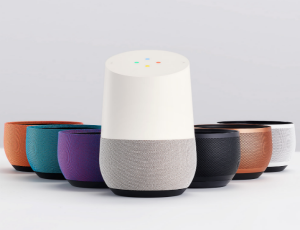
Photo Credit: Google.
So how do we get to the 24th century computer from here? The announcements Google made on Oct. 4 took a big step in that direction. Both Google Home and Google Assistant (the heart of the new Pixel phone) bring Google’s experience with artificial intelligence to bear — and Google is training us to use technology in new ways.
The Google Assistant landing page invites visitors to use voice queries: “Ask it questions. Tell it to do things. Tell your Assistant to play jazz on the living room speakers, set your ‘go to gym’ alarm, make a reservation …”
SEOs see that and wonder: Where is there space for a SERP in there?
A SERP presents many results and lets a searcher click their choice. But voice searchers talking to Google Home have a different experience. Google wants to let the Assistant eliminate choices when there’s a clear best option — and “best” is defined by the Assistant.
Obviously, not all queries can have a single response. As you might imagine, a lot of the things we search for need a selection of answers or opinions. But do we need 15,000,000 opinions? Do we even need 10?
Example: I have a pretty small selection of power tools in a very small garage, but I’m getting into some simple woodworking. I recently needed to figure out how to quickly cut a 4″ diameter hole in some 1″ x 8″ pine. So I Googled it.
I really had to comb through the results based on my limited tool collection; a lot of the answers I ignored because they just weren’t helpful.
Now imagine doing that as a voice search with Google Home. I might hear many options the first time I searched. But because of machine learning, eventually Google would recall the particular site (or group of sites) that really caters to my skill level and figure out that out of the 15,000,000 results for “how to cut circles in wood” there might be 4 that are actually useful to me. That’s important information for Assistant; if I ask a question to Google Home while I’m in the garage plugging my jigsaw in, I don’t really want it reading 10 articles to me.
How Will Google Home Affect My SEO Strategy?
A lot of businesses have been doing online marketing, SEO, and PPC for long enough that it’s easy to think we have lots of time to catch up, or surpass, competitors.
While I’m not saying the SERPs are going away anytime soon, I do think that the increased emphasis on personalization is only going to make it harder to find new customers.
If you make a living off of publishing restaurant reviews, and people start using Assistant to find out about a new burger joint instead of Googling it, then Assistant will (likely) pull from one source to get reviews. New users might not even see your site as an option.
By the way, we have no clues yet on where AdWords may one day fit into a Google Home result.
Be Indispensable
Is the rise of spoken search results bad news for sites that aren’t Yelp, Wikipedia, or YouTube?
No! But it’s bad news for businesses who aren’t putting in the work to understand their audience. It’s bad news for businesses who aren’t willing to grow with their customers’ evolving needs.
If your business is willing to talk to your customers, to find out what your competitors are missing, then this new search technology is good news. Because the only way to be algorithm proof, the only way to secure a lasting position in the evolving world of search, is to be indispensable. So ask yourself this: Would the SERPs be lacking without your site?
Do some user experience testing. Survey your customers. Talk to your customer service reps to identify common questions or complaints, then address them. Figure out what your customers do just before and just after converting on your site; if you can help them perform some of those repetitive actions, you’ve suddenly simplified their lives.
This can be as simple as a good “People also bought” widget that anticipates the next need. If the user adds a nail gun to the cart, why not suggest some popular nails that fit the gun? Or, if it’s a hydraulic nail gun, maybe the user would like to know about a sale you’re having on air compressors.
Understand Your Analytics
The other thing to keep in mind here is that less traffic isn’t always a bad thing. A broad trend some of us in SEO have noticed is that many sites aren’t ranking for as many queries as they used to, which at first seems like terrible news. But many of those same sites are actually seeing better rankings for more specific queries, and a concurrent increase in conversions. As the search engines get better at understanding user intent, and as search becomes more and more personalized, rankings will be harder to track, and (in many instances) harder to get. But if your visits drop while your conversion rate improves, then that’s a net gain (assuming that you’re in business to make money, of course).
The one exception to this, of course, is sites that are dependent on page views for revenue (i.e., ad-heavy sites). I think now would be a good time to start developing a secondary revenue stream/way to monetize your site that you can grow over time, as people are spending less and less time on the SERPs.
Missed the Oct. 4 press conference where Google announced the debut of Google Home, Google Pixel and more? Watch the announcement below.
September 29, 2016
Learn How to Optimize for Voice Search NOW: More than Half of Queries will be Voice Search Queries by 2020
Learn How to Optimize for Voice Search NOW: More than Half of Queries will be Voice Search Queries by 2020 was originally published on BruceClay.com, home of expert search engine optimization tips.
By 2020, there will be 200 billion voice search queries per month and more than half of searches will come from voice search, according to comScore research. Digital marketers need to invest in strategies that target voice searchers. Read on to get tips on optimizing for voice search with perspectives from a search agency (with Bing’s Purna Virji), a publisher (The SEM Post’s Jennifer Slegg) and an SEO (Elite SEM’s Tony Edward).

From left: Tony Edwards, Purna Virji and Jennifer Slegg
Bing’s Purna Virji on the Evolution of Voice Search
Purna Virji, the senior training manager at Microsoft, talked about how voice search is shaping our world. Everything from television remotes to hotel rooms can be powered by voice. By 2017, all Ford vehicles will come with Apple CarPlay.
Reasons People Use Voice Search
It’s faster than typing. You can speak 110–150 words per minute, as opposed to the average person’s typing rate of 38–40 words per minute.
You can speak 110–150 words per min, as opposed to avg person’s typing 38–40 wpm. -@purnavirji…
Click To Tweet
People want quick answers.
People are often second screening or otherwise occupied

(click to enlarge)
The Evolution of Voice Search By Purna Virji from Search Marketing Expo – SMX
Jennifer Slegg on Content for the Voice Search Generation
Like Virji, the founder and editor of The SEM Post, Jennifer Slegg, believes the time to optimize for voice search is now.
Consider the fact that more than half of U.S. teens and 41% of adults use voice search on a daily basis, or that there are 30 times more action queries on voice search.
How Feature Snippets Work with Voice Search
Voice search has a higher percentage of featured snippets. Slegg says 43.3% for voice queries have featured snippets, compared to 40.6% for text queries.
Moreover, Google reads the featured snippets aloud to users beginning with “According to (site)” or “We found this information on (site).” Google reinforces your brand in voice search. (Learn how to earn featured snippets in 2016.)
Use Moz and SEMRush to track your own and your competitors’ featured snippets.
RankBrain and Voice Search
Stronger influence on 15% of search queries Google has never seen before, and they tend to be voice searches.
You’re able to better rank conversational search queries with keywords.
It’s the third most important ranking signal, behind content and links.
How do you optimize for RankBrain? By optimizing for conversational search.
How to Optimize for Voice Search
Voice search queries are longer than text search queries. The average query length for voice is 4.2 words, and the average query length for text is 3.2 words.
Long-tail queries are less competitive and have higher intent. While they’re searched for less, they’re more likely to convert.
Use your content to answer questions. There is a 61% growth in queries starting with who, what, where and how. Furthermore, almost 10% of voice search queries start with who, what, when, where, why, how – as opposed to only 3.7% of text queries. “How” begins 3.6% of all voice search queries and “What” begins 3.5% of all voice search queries.
Content Optimization For The Voice Search Generation By Jennifer Slegg from Search Marketing Expo – SMX
Tony Edward on How Humans Speak
Tony Edward, the senior SEO manager at Elite SEM, reminded digital marketers that optimizing for voice search begins with standard SEO best practices.
Build in-depth content that answers commonly asked questions around your brand, services, products, etc., including content that answers who, what, when, where, why and how.
Leverage Structured Data Markup depending on the content type.
Work to get your brand in the Knowledge Graph.
Ensure content is structured well using headers and bulleted or numbered lists.
Edward shared his tips on coming up with content strategy:
Mine call center, live chat and email data to find commonly asked questions surrounding your product, service or brand.
Use third-party tools to get auto search suggestion topics, such as AnswerThePublic.com or UberSuggest.io.
By implementing the above best practices and creating useful content, Edward has been able to earn branded Knowledge Graphs and Featured Snippets. As noted earlier, getting a branded Knowledge Graph entry or Featured Snippet makes your result more voice search ready.
Optimizing Content For Voice Search & Virtual Assistants By Tony Edward from Search Marketing Expo – SMX
Bruce Clay, Inc. is a global digital marketing agency specializing in SEO services, SEM PPC, content development and social media marketing. Looking for a partner to grow your online business presence? Let’s talk.

